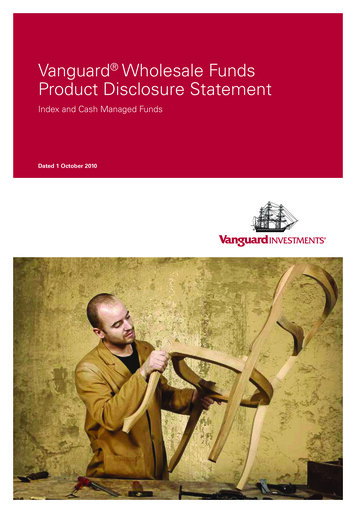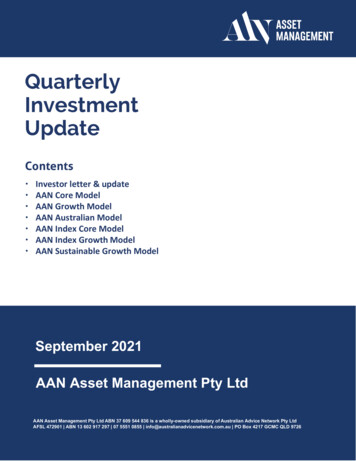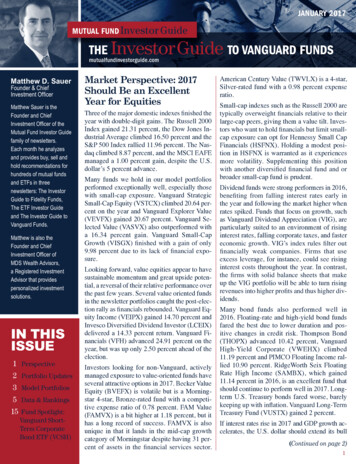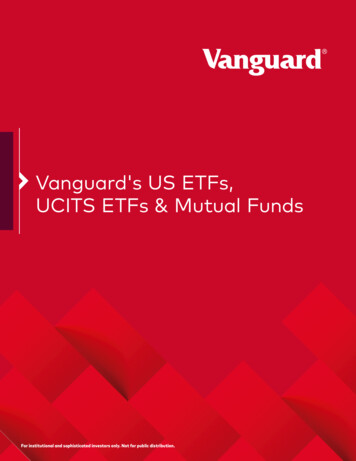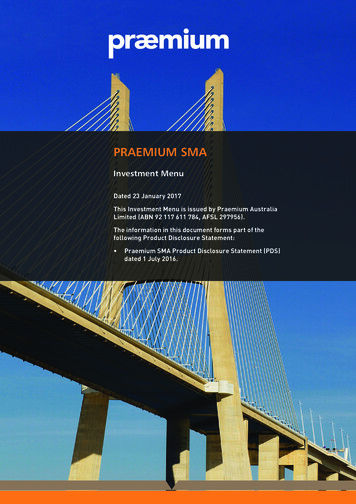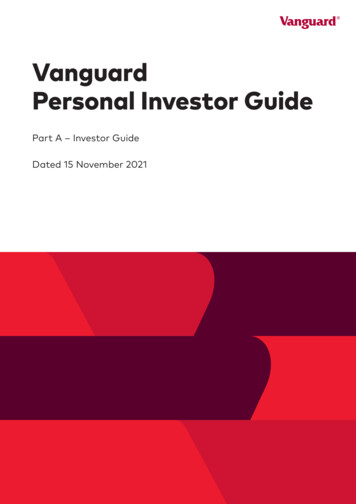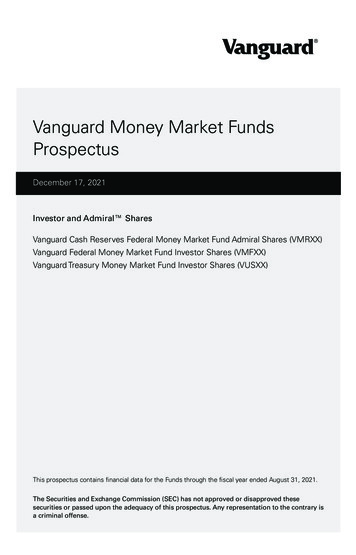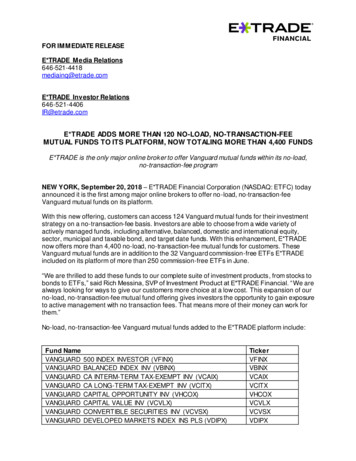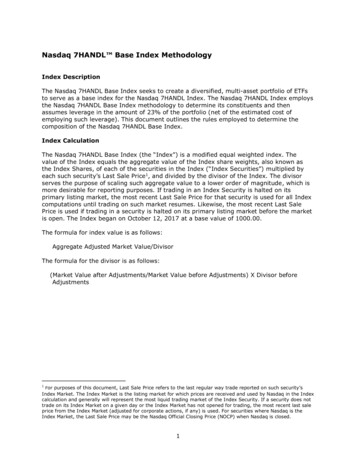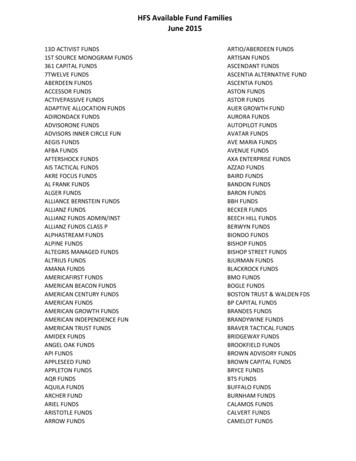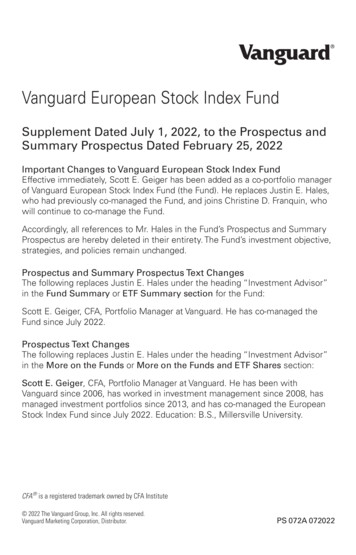
Transcription
Vanguard European Stock Index FundSupplement Dated July 1, 2022, to the Prospectus andSummary Prospectus Dated February 25, 2022Important Changes to Vanguard European Stock Index FundEffective immediately, Scott E. Geiger has been added as a co-portfolio managerof Vanguard European Stock Index Fund (the Fund). He replaces Justin E. Hales,who had previously co-managed the Fund, and joins Christine D. Franquin, whowill continue to co-manage the Fund.Accordingly, all references to Mr. Hales in the Fund’s Prospectus and SummaryProspectus are hereby deleted in their entirety. The Fund’s investment objective,strategies, and policies remain unchanged.Prospectus and Summary Prospectus Text ChangesThe following replaces Justin E. Hales under the heading “Investment Advisor”in the Fund Summary or ETF Summary section for the Fund:Scott E. Geiger, CFA, Portfolio Manager at Vanguard. He has co-managed theFund since July 2022.Prospectus Text ChangesThe following replaces Justin E. Hales under the heading “Investment Advisor”in the More on the Funds or More on the Funds and ETF Shares section:Scott E. Geiger, CFA, Portfolio Manager at Vanguard. He has been withVanguard since 2006, has worked in investment management since 2008, hasmanaged investment portfolios since 2013, and has co-managed the EuropeanStock Index Fund since July 2022. Education: B.S., Millersville University.CFA is a registered trademark owned by CFA Institute 2022 The Vanguard Group, Inc. All rights reserved.Vanguard Marketing Corporation, Distributor.PS 072A 072022
Vanguard International Stock Index FundsProspectusFebruary 25, 2022Investor SharesVanguard European Stock Index Fund Investor Shares (VEURX)Vanguard Pacific Stock Index Fund Investor Shares (VPACX)Vanguard Emerging Markets Stock Index Fund Investor Shares (VEIEX)This prospectus contains financial data for the Funds through the fiscal year ended October 31, 2021.The Securities and Exchange Commission (SEC) has not approved or disapproved thesesecurities or passed upon the adequacy of this prospectus. Any representation to the contrary isa criminal offense.
ContentsFund SummariesInvesting With Vanguard37Vanguard European Stock Index Fund1Purchasing Shares37Vanguard Pacific Stock Index Fund6Converting Shares40Vanguard Emerging Markets Stock Index Fund 11Redeeming Shares4217Exchanging Shares46Investing in Index FundsMore on the Funds18Frequent-Trading Limitations46The Funds and Vanguard26Other Rules You Should Know49Investment Advisor26Fund and Account Updates53Dividends, Capital Gains, and Taxes28Employer-Sponsored Plans54Share Price32Contacting Vanguard5634Additional Information56Financial HighlightsGlossary of Investment Terms59
Vanguard European Stock Index FundInvestment ObjectiveThe Fund seeks to track the performance of a benchmark index that measuresthe investment return of stocks issued by companies located in the majormarkets of Europe.Fees and ExpensesThe following table describes the fees and expenses you may pay if you buy,hold, and sell Investor Shares of the Fund. You may pay other fees, such asbrokerage commissions and other fees to financial intermediaries, which are notreflected in the table and example below.Shareholder Fees(Fees paid directly from your investment)Sales Charge (Load) Imposed on PurchasesPurchase FeeNoneNoneSales Charge (Load) Imposed on Reinvested DividendsRedemption FeeNoneNoneAccount Service Fee Per Year(for certain fund account balances below 10,000) 20Annual Fund Operating Expenses(Expenses that you pay each year as a percentage of the value of your investment)Management Fees0.21%12b-1 Distribution FeeOther ExpensesTotal Annual Fund Operating ExpensesNone0.02%0.23%1
ExampleThe following example is intended to help you compare the cost of investing inthe Fund’s Investor Shares with the cost of investing in other mutual funds. Itillustrates the hypothetical expenses that you would incur over various periods ifyou were to invest 10,000 in the Fund’s shares. This example assumes that theshares provide a return of 5% each year and that total annual fund operatingexpenses remain as stated in the preceding table. You would incur thesehypothetical expenses whether or not you were to redeem your investment atthe end of the given period. Although your actual costs may be higher or lower,based on these assumptions your costs would be:1 Year 243 Years 745 Years 13010 Years 293Portfolio TurnoverThe Fund pays transaction costs, such as commissions, when it buys and sellssecurities (or “turns over” its portfolio). A higher portfolio turnover rate mayindicate higher transaction costs and may result in more taxes when Fundshares are held in a taxable account. These costs, which are not reflected inannual fund operating expenses or in the previous expense example, reduce theFund’s performance. During the most recent fiscal year, the Fund’s portfolioturnover rate was 3% of the average value of its portfolio.Principal Investment StrategiesThe Fund employs an indexing investment approach by investing all, orsubstantially all, of its assets in the common stocks included in the FTSEDeveloped Europe All Cap Index. As of October 31, 2021, the FTSE DevelopedEurope All Cap Index is a market-capitalization-weighted index that is made up ofapproximately 1,311 common stocks of large-, mid-, and small-cap companieslocated in 16 European countries—mostly companies in the United Kingdom,France, Switzerland, and Germany. Other countries represented in the Indexinclude Austria, Belgium, Denmark, Finland, Ireland, Italy, Netherlands, Norway,Poland, Portugal, Spain, and Sweden.Principal RisksAn investment in the Fund could lose money over short or long periods of time.You should expect the Fund’s share price and total return to fluctuate within awide range. The Fund is subject to the following risks, which could affect theFund’s performance: Stock market risk, which is the chance that stock prices overall will decline.Stock markets tend to move in cycles, with periods of rising prices and periods2
of falling prices. The Fund’s investments in foreign stocks can be riskier than U.S.stock investments. Foreign stocks may be more volatile and less liquid than U.S.stocks. The prices of foreign stocks and the prices of U.S. stocks may move inopposite directions. In addition, the Fund’s target index may, at times, becomefocused in stocks of a particular market sector, which would subject the Fund toproportionately higher exposure to the risks of that sector. Country/regional risk, which is the chance that world events—such as politicalupheaval, financial troubles, or natural disasters—will adversely affect the valueof securities issued by companies in foreign countries or regions. The Index’s,and therefore the Fund’s, heavy exposure to four countries (the United Kingdom,France, Germany, and Switzerland) subjects the Fund to a higher degree ofcountry risk than that of more geographically diversified international funds. Currency risk, which is the chance that the value of a foreign investment,measured in U.S. dollars, will decrease because of unfavorable changes incurrency exchange rates.An investment in the Fund is not a deposit of a bank and is not insured orguaranteed by the Federal Deposit Insurance Corporation or any othergovernment agency.Annual Total ReturnsThe following bar chart and table are intended to help you understand the risksof investing in the Fund. The bar chart shows how the performance of the Fund‘sInvestor Shares has varied from one calendar year to another over the periodsshown. The table shows how the average annual total returns of the shareclasses presented compare with those of the Fund’s target index and othercomparative indexes, which have investment characteristics similar to those ofthe Fund. The Spliced European Stock Index reflects the performance of theMSCI Europe Index through March 26, 2013; the FTSE Developed Europe Indexthrough September 30, 2015; and the FTSE Developed Europe All Cap Indexthereafter. Returns for the FTSE Indexes shown are adjusted for withholdingtaxes applicable to U.S.-based mutual funds organized as Delaware statutorytrusts. Keep in mind that the Fund’s past performance (before and after taxes)does not indicate how the Fund will perform in the future. Updated performanceinformation is available on our website at vanguard.com/performance or bycalling Vanguard toll-free at 800-662-7447.3
Annual Total Returns — Vanguard European Stock Index Fund Investor 0–6.67–0.80–2.00–14.86During the periods shown in the bar chart, the highest and lowest returns for acalendar quarter were:HighestLowestTotal Return17.45%-25.69%QuarterJune 30, 2020March 31, 2020Average Annual Total Returns for Periods Ended December 31, 20211 Year5 Years10 YearsVanguard European Stock Index Fund Investor SharesReturn Before TaxesReturn After Taxes on Distributions16.19% 10.59%15.379.868.50%7.76Return After Taxes on Distributions and Sale of Fund SharesFTSE Developed Europe All Cap Index(reflects no deduction for fees or expenses)Spliced European Stock Index(reflects no deduction for fees or expenses)10.136.80FTSE Global All Cap ex US Index(reflects no deduction for fees or expenses)8.3216.35% 10.69%8.92%16.3510.698.608.849.927.76Actual after-tax returns depend on your tax situation and may differ from thoseshown in the preceding table. When after-tax returns are calculated, it isassumed that the shareholder was in the highest individual federal marginalincome tax bracket at the time of each distribution of income or capital gains orupon redemption. State and local income taxes are not reflected in thecalculations. Please note that after-tax returns are not relevant for a shareholderwho holds fund shares in a tax-deferred account, such as an individual retirementaccount or a 401(k) plan. Also, figures captioned Return After Taxes onDistributions and Sale of Fund Shares may be higher than other figures for thesame period if a capital loss occurs upon redemption and results in an assumedtax deduction for the shareholder.4
Investment AdvisorThe Vanguard Group, Inc. (Vanguard)Portfolio ManagersChristine D. Franquin, Principal of Vanguard. She has co-managed the Fundsince 2016.Justin E. Hales, CFA, CFP, Portfolio Manager at Vanguard. He has co-managedthe Fund since 2016.Purchase and Sale of Fund SharesYou may purchase or redeem shares online through our website (vanguard.com),by mail (The Vanguard Group, P.O. Box 982901, El Paso, TX 79998-2901), or bytelephone (800-662-2739). Investor Shares are generally available only toVanguard funds that operate as funds of funds and to certain retirement planclients that receive recordkeeping services from Vanguard. Financialintermediaries, institutional clients, and Vanguard-advised clients should contactVanguard for information on special eligibility rules that may apply to themregarding Investor Shares. If you are investing through an intermediary, pleasecontact that firm directly for more information regarding your eligibility. If you areinvesting through an employer-sponsored retirement or savings plan, your planadministrator or your benefits office can provide you with detailed information onhow you can invest through your plan.Tax InformationThe Fund’s distributions may be taxable as ordinary income or capital gain. If youare investing through a tax-advantaged account, such as an IRA or anemployer-sponsored retirement or savings plan, special tax rules apply.Payments to Financial IntermediariesThe Fund and its investment advisor do not pay financial intermediaries for salesof Fund shares.5
Vanguard Pacific Stock Index FundInvestment ObjectiveThe Fund seeks to track the performance of a benchmark index that measuresthe investment return of stocks issued by companies located in the majormarkets of the Pacific region.Fees and ExpensesThe following table describes the fees and expenses you may pay if you buy,hold, and sell Investor Shares of the Fund. You may pay other fees, such asbrokerage commissions and other fees to financial intermediaries, which are notreflected in the table and example below.Shareholder Fees(Fees paid directly from your investment)Sales Charge (Load) Imposed on PurchasesPurchase FeeNoneNoneSales Charge (Load) Imposed on Reinvested DividendsRedemption FeeNoneNoneAccount Service Fee Per Year(for certain fund account balances below 10,000) 20Annual Fund Operating Expenses(Expenses that you pay each year as a percentage of the value of your investment)Management Fees0.22%12b-1 Distribution FeeOther ExpensesTotal Annual Fund Operating ExpensesNone0.01%0.23%6
ExampleThe following example is intended to help you compare the cost of investing inthe Fund’s Investor Shares with the cost of investing in other mutual funds. Itillustrates the hypothetical expenses that you would incur over various periods ifyou were to invest 10,000 in the Fund’s shares. This example assumes that theshares provide a return of 5% each year and that total annual fund operatingexpenses remain as stated in the preceding table. You would incur thesehypothetical expenses whether or not you were to redeem your investment atthe end of the given period. Although your actual costs may be higher or lower,based on these assumptions your costs would be:1 Year 243 Years 745 Years 13010 Years 293Portfolio TurnoverThe Fund pays transaction costs, such as commissions, when it buys and sellssecurities (or “turns over” its portfolio). A higher portfolio turnover rate mayindicate higher transaction costs and may result in more taxes when Fundshares are held in a taxable account. These costs, which are not reflected inannual fund operating expenses or in the previous expense example, reduce theFund’s performance. During the most recent fiscal year, the Fund’s portfolioturnover rate was 5% of the average value of its portfolio.Principal Investment StrategiesThe Fund employs an indexing investment approach by investing all, orsubstantially all, of its assets in the common stocks included in the FTSEDeveloped Asia Pacific All Cap Index. As of October 31, 2021, the FTSEDeveloped Asia Pacific All Cap Index is a market-capitalization weighted indexthat is made up of approximately 2,443 common stocks of large-, mid-, andsmall-cap companies located in Japan, Australia, Korea, Hong Kong, Singapore,and New Zealand.Principal RisksAn investment in the Fund could lose money over short or long periods of time.You should expect the Fund’s share price and total return to fluctuate within awide range. The Fund is subject to the following risks, which could affect theFund’s performance: Stock market risk, which is the chance that stock prices overall will decline.Stock markets tend to move in cycles, with periods of rising prices and periodsof falling prices. The Fund’s investments in foreign stocks can be riskier than U.S.stock investments. Foreign stocks may be more volatile and less liquid than U.S.7
stocks. The prices of foreign stocks and the prices of U.S. stocks may move inopposite directions. In addition, the Fund’s target index may, at times, becomefocused in stocks of a particular market sector, which would subject the Fund toproportionately higher exposure to the risks of that sector. Country/regional risk, which is the chance that world events—such as politicalupheaval, financial troubles, or natural disasters—will adversely affect the valueof securities issued by companies in foreign countries or regions. The Index’s,and therefore the Fund’s, heavy exposure to Japan, Australia, and Korea subjectsthe Fund to a higher degree of country risk than that of more geographicallydiversified international funds. Currency risk, which is the chance that the value of a foreign investment,measured in U.S. dollars, will decrease because of unfavorable changes incurrency exchange rates.An investment in the Fund is not a deposit of a bank and is not insured orguaranteed by the Federal Deposit Insurance Corporation or any othergovernment agency.Annual Total ReturnsThe following bar chart and table are intended to help you understand the risksof investing in the Fund. The bar chart shows how the performance of the Fund‘sInvestor Shares has varied from one calendar year to another over the periodsshown. The table shows how the average annual total returns of the shareclasses presented compare with those of the Fund’s target index and othercomparative indexes, which have investment characteristics similar to those ofthe Fund. The Spliced Pacific Stock Index reflects the performance of the MSCIPacific Index through March 26, 2013; the FTSE Developed Asia Pacific Indexthrough September 30, 2015; and the FTSE Developed Asia Pacific All Cap Indexthereafter. Returns for the FTSE Indexes shown are adjusted for withholdingtaxes applicable to U.S.-based mutual funds organized as Delaware statutorytrusts. Keep in mind that the Fund’s past performance (before and after taxes)does not indicate how the Fund will perform in the future. Updated performanceinformation is available on our website at vanguard.com/performance or bycalling Vanguard toll-free at 800-662-7447.8
Annual Total Returns — Vanguard Pacific Stock Index Fund Investor 92.251.36–4.69–13.98During the periods shown in the bar chart, the highest and lowest returns for acalendar quarter were:HighestLowestTotal Return18.09%-20.89%QuarterDecember 31, 2020March 31, 2020Average Annual Total Returns for Periods Ended December 31, 20211 Year5 Years10 YearsReturn Before TaxesReturn After Taxes on Distributions1.36%0.588.87%8.197.83%7.16Return After Taxes on Distributions and Sale of Fund SharesFTSE Developed Asia Pacific All Cap Index(reflects no deduction for fees or expenses)Spliced Pacific Stock Index(reflects no deduction for fees or 849.927.76Vanguard Pacific Stock Index Fund Investor SharesFTSE Global All Cap ex US Index(reflects no deduction for fees or expenses)Actual after-tax returns depend on your tax situation and may differ from thoseshown in the preceding table. When after-tax returns are calculated, it isassumed that the shareholder was in the highest individual federal marginalincome tax bracket at the time of each distribution of income or capital gains orupon redemption. State and local income taxes are not reflected in thecalculations. Please note that after-tax returns are not relevant for a shareholderwho holds fund shares in a tax-deferred account, such as an individual retirementaccount or a 401(k) plan. Also, figures captioned Return After Taxes onDistributions and Sale of Fund Shares may be higher than other figures for thesame period if a capital loss occurs upon redemption and results in an assumedtax deduction for the shareholder.9
Investment AdvisorThe Vanguard Group, Inc. (Vanguard)Portfolio ManagersMichael Perre, Principal of Vanguard. He has co-managed the Fund since 2016.Jeffrey D. Miller, Portfolio Manager at Vanguard. He has co-managed the Fundsince 2016.Purchase and Sale of Fund SharesYou may purchase or redeem shares online through our website (vanguard.com),by mail (The Vanguard Group, P.O. Box 982901, El Paso, TX 79998-2901), or bytelephone (800-662-2739). Investor Shares are generally available only toVanguard funds that operate as funds of funds and to certain retirement planclients that receive recordkeeping services from Vanguard. Financialintermediaries, institutional clients, and Vanguard-advised clients should contactVanguard for information on special eligibility rules that may apply to themregarding Investor Shares. If you are investing through an intermediary, pleasecontact that firm directly for more information regarding your eligibility. If you areinvesting through an employer-sponsored retirement or savings plan, your planadministrator or your benefits office can provide you with detailed information onhow you can invest through your plan.Tax InformationThe Fund’s distributions may be taxable as ordinary income or capital gain. If youare investing through a tax-advantaged account, such as an IRA or anemployer-sponsored retirement or savings plan, special tax rules apply.Payments to Financial IntermediariesThe Fund and its investment advisor do not pay financial intermediaries for salesof Fund shares.10
Vanguard Emerging Markets Stock Index FundInvestment ObjectiveThe Fund seeks to track the performance of a benchmark index that measuresthe investment return of stocks issued by companies located in emergingmarket countries.Fees and ExpensesThe following table describes the fees and expenses you may pay if you buy,hold, and sell Investor Shares of the Fund. You may pay other fees, such asbrokerage commissions and other fees to financial intermediaries, which are notreflected in the table and example below.Shareholder Fees(Fees paid directly from your investment)Sales Charge (Load) Imposed on PurchasesPurchase FeeNoneNoneSales Charge (Load) Imposed on Reinvested DividendsRedemption FeeNoneNoneAccount Service Fee Per Year(for certain fund account balances below 10,000) 20Annual Fund Operating Expenses(Expenses that you pay each year as a percentage of the value of your investment)Management Fees0.27%12b-1 Distribution FeeOther ExpensesTotal Annual Fund Operating ExpensesNone0.02%0.29%11
ExampleThe following example is intended to help you compare the cost of investing inthe Fund’s Investor Shares with the cost of investing in other mutual funds. Itillustrates the hypothetical expenses that you would incur over various periods ifyou were to invest 10,000 in the Fund’s shares. This example assumes that theshares provide a return of 5% each year and that total annual fund operatingexpenses remain as stated in the preceding table. You would incur thesehypothetical expenses whether or not you were to redeem your investment atthe end of the given period. Although your actual costs may be higher or lower,based on these assumptions your costs would be:1 Year 303 Years 935 Years 16310 Years 368Portfolio TurnoverThe Fund pays transaction costs, such as commissions, when it buys and sellssecurities (or “turns over” its portfolio). A higher portfolio turnover rate mayindicate higher transaction costs and may result in more taxes when Fundshares are held in a taxable account. These costs, which are not reflected inannual fund operating expenses or in the previous expense example, reduce theFund’s performance. During the most recent fiscal year, the Fund’s portfolioturnover rate was 9% of the average value of its portfolio.Principal Investment StrategiesThe Fund employs an indexing investment approach designed to track theperformance of the FTSE Emerging Markets All Cap China A Inclusion Index. Asof October 31, 2021, the FTSE Emerging Markets All Cap China A InclusionIndex is a market-capitalization-weighted index that is made up of approximately4,284 common stocks of large-, mid-, and small-cap companies located inemerging markets around the world. The Fund invests by sampling the Index,meaning that it holds a broadly diversified collection of securities that, in theaggregate, approximates the Index in terms of key characteristics. These keycharacteristics include industry weightings and market capitalization, as well ascertain financial measures, such as price/earnings ratio and dividend yield.Principal RisksAn investment in the Fund could lose money over short or long periods of time.You should expect the Fund’s share price and total return to fluctuate within awide range. The Fund is subject to the following risks, which could affect theFund’s performance:12
Stock market risk, which is the chance that stock prices overall will decline.Stock markets tend to move in cycles, with periods of rising prices and periodsof falling prices. The Fund’s investments in foreign stocks can be riskier than U.S.stock investments. Foreign stocks may be more volatile and less liquid than U.S.stocks. The prices of foreign stocks and the prices of U.S. stocks may move inopposite directions. In addition, the Fund’s target index may, at times, becomefocused in stocks of a particular market sector, which would subject the Fund toproportionately higher exposure to the risks of that sector. Emerging markets risk, which is the chance that the stocks of companieslocated in emerging markets will be substantially more volatile, and substantiallyless liquid, than the stocks of companies located in more developed foreignmarkets because, among other factors, emerging markets can have greatercustodial and operational risks; less developed legal, tax, regulatory, financialreporting, accounting, and recordkeeping systems; and greater political, social,and economic instability than developed markets. Country/regional risk, which is the chance that world events—such as politicalupheaval, financial troubles, or natural disasters—will adversely affect the valueof securities issued by companies in foreign countries or regions. Because theFund may invest a large portion of its assets in securities of companies locatedin any one country or region, the Fund’s performance may be hurtdisproportionately by the poor performance of its investments in that area. Currency risk, which is the chance that the value of a foreign investment,measured in U.S. dollars, will decrease because of unfavorable changes incurrency exchange rates. Currency risk is especially high in emerging markets. China A-shares risk, which is the chance that the Fund may not be able toaccess its desired amount of China A-shares. Investing in A-shares throughStock Connect or the QFI program is subject to trading restrictions andsuspensions, quota limitations and sudden changes in those limitations, andoperational, clearing, and settlement risks. Index sampling risk, which is the chance that the securities selected for theFund, in the aggregate, will not provide investment performance matching thatof the Fund’s target index.An investment in the Fund is not a deposit of a bank and is not insured orguaranteed by the Federal Deposit Insurance Corporation or any othergovernment agency.13
Annual Total ReturnsThe following bar chart and table are intended to help you understand the risksof investing in the Fund. The bar chart shows how the performance of the Fund‘sInvestor Shares has varied from one calendar year to another over the periodsshown. The table shows how the average annual total returns of the shareclasses presented compare with those of the Fund’s target index and othercomparative indexes, which have investment characteristics similar to those ofthe Fund. The Spliced Emerging Markets Index reflects the performance of theMSCI Emerging Markets Index through January 9, 2013; the FTSE EmergingTransition Index through June 27, 2013; the FTSE Emerging Index throughNovember 1, 2015; the FTSE Emerging Markets All Cap China A Transition Indexthrough September 18, 2016; and the FTSE Emerging Markets All Cap China AInclusion Index thereafter. Returns for the FTSE Indexes shown are adjusted forwithholding taxes applicable to U.S.-based mutual funds organized as Delawarestatutory trusts. Keep in mind that the Fund’s past performance (before and aftertaxes) does not indicate how the Fund will perform in the future. Updatedperformance information is available on our website atvanguard.com/performance or by calling Vanguard toll-free at 800-662-7447.Annual Total Returns — Vanguard Emerging Markets Stock Index Fund Investor 9–14.71–15.47-40%During the periods shown in the bar chart, the highest and lowest returns for acalendar quarter were:HighestLowest14Total Return19.84%-24.59%QuarterJune 30, 2020March 31, 2020
Average Annual Total Returns for Periods Ended December 31, 20211 Year5 Years10 YearsReturn Before TaxesReturn After Taxes on Distributions0.73%0.079.26%8.535.19%4.49Return After Taxes on Distributions and Sale of Fund SharesFTSE Emerging Markets All Cap China A Inclusion Index(reflects no deduction for fees or expenses)Spliced Emerging Markets Index(reflects no deduction for fees or 849.927.76Vanguard Emerging Markets Stock Index FundInvestor SharesFTSE Global All Cap ex US Index(reflects no deduction for fees or expenses)Actual after-tax returns depend on your tax situation and may differ from thoseshown in the preceding table. When after-tax returns are calculated, it isassumed that the shareholder was in the highest individual federal marginalincome tax bracket at the time of each distribution of income or capital gains orupon redemption. State and local income taxes are not reflected in thecalculations. Please note that after-tax returns are not relevant for a shareholderwho holds fund shares in a tax-deferred account, such as an individual retirementaccount or a 401(k) plan. Also, figures captioned Return After Taxes onDistributions and Sale of Fund Shares may be higher than other figures for thesame period if a capital loss occurs upon redemption and results in an assumedtax deduction for the shareholder.Investment AdvisorThe Vanguard Group, Inc. (Vanguard)Portfolio ManagersMichael Perre, Principal of Vanguard. He has managed the Fund since 2008(co-managed since 2016).Jeffrey D. Miller, Portfolio Manager at Vanguard. He has co-managed the Fundsince 2016.Purchase and Sale of Fund SharesYou may purchase or redeem shares online through our website (vanguard.com),by mail (The Vanguard Group, P.O. Box 982901, El Paso, TX 79998-2901), or bytelephone (800-662-2739). Investor Shares are generally available only toVanguard funds that operate as funds of funds and to certain retirement planclients that receive reco
Vanguard Pacific Stock Index Fund Investor Shares (VPACX) Vanguard Emerging Markets Stock Index Fund Investor Shares (VEIEX) This prospectus contains financial data for the Funds through the fiscal year ended October 31, 2021. . Redemption Fee None Account Service Fee PerYear (for certain fund account balances below 10,000) 20
